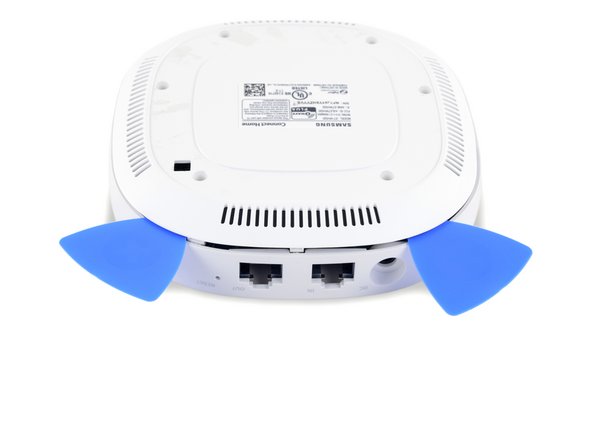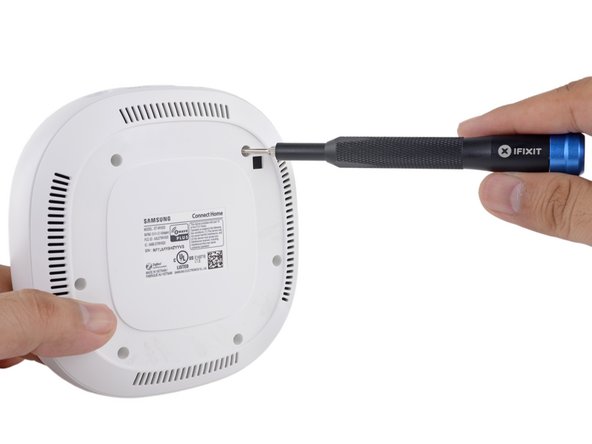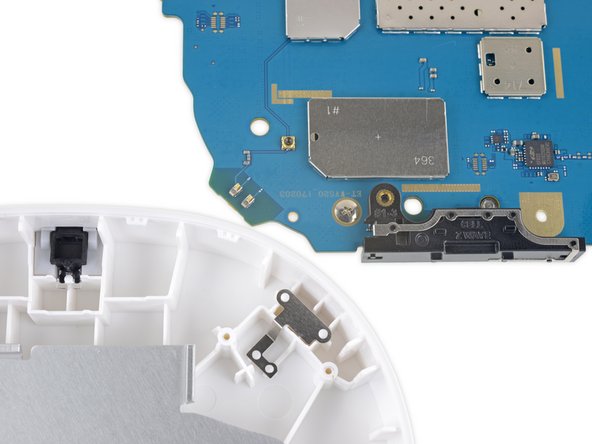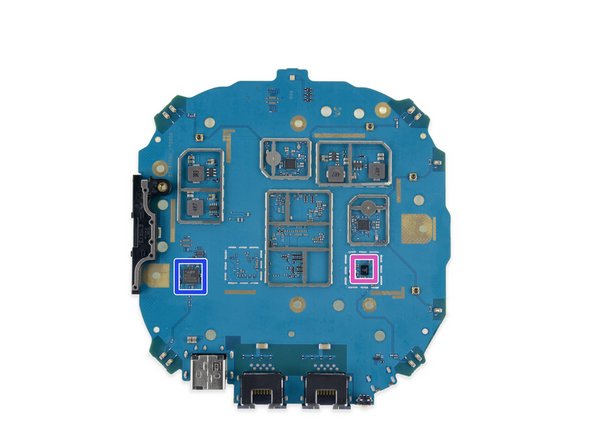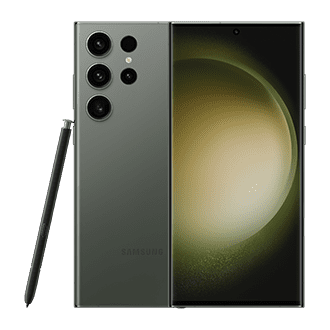Samsung Connect Home Teardown
Duration: 45 minutes
Steps: 8 Steps
Meet Samsung’s Connect Home, the ultimate smart router that takes charge of all your SmartThings! Ever wonder what kind of wizardry powers this device? Let’s dive in and uncover its secrets! If you’re looking to connect with us, find us on Facebook, Instagram, and Twitter. And if you want to stay updated on our latest teardowns, don’t forget to sign up for our newsletter!
Step 1
– Ever wondered what this nifty circuit-filled puck can do? Well, let’s dive in!
– If you decided to go for the sleek Connect Home Pro, you’re in for a treat with some upgraded Wi-Fi goodness:
– Wi-Fi speeds: 400 Mbps @ 2.4 GHz and 866 Mbps @ 5 GHz (AC1300).
– Enjoy wireless coverage of up to 1,500 square feet.
– Connect with SmartThings using Bluetooth, Zigbee, and Z Wave.
– And hey, if you’re feeling sporty, you can even play hockey!
– Wi-Fi speeds: 800 Mbps @ 2.4 GHz and a whopping 1,733 Mbps @ 5 GHz (AC2600).
Step 2
We hoped the bottom sticker would reveal some wild secrets, but it’s just serial numbers and wireless certifications hanging out down here.
– Nope, not a secret droid—just the back of the Connect!
– There are grill vents running along all four edges of the bottom panel to help keep things cool.
– Keeping it simple, the Connect Home gives you three ports: one for power, one for WAN, one for LAN, and a handy reset pinhole.
Step 3
– Our first step is to check for screws hidden in a familiar spot—under a rubber foot. Next, you’ll spot some screw holes that might look tricky, but surprise—those are the ones! They’re standard Phillips #00 screws—props to Samsung for keeping things simple. These opening picks are handy not just for cracking open stubborn cases, but they can also give your device a little flip-flop, making the job easier. Just a heads-up: it’s probably best not to let your device take a swim, so handle with care.
Step 4
That’s a lot of cooling power packed into a pretty low-key router.
– Wow, it’s heating up in here! First off, we’ve got our eyes on a gigantic ducted heatsink—what’s it cooling down in this little powerhouse?
– And just when we thought the Home had a hefty heatsink, the Connect Pro decided to join the party with its very own fan!
– Peeking beneath the Connect’s heatsink reveals a sizable shielded area—just another little mystery keeping us away from the chips we’re eager to meet.
Step 5
– On the back of the board we spy the Z-wave antenna (the black rectangle on the left), and some metal contact clips mounted in the case.
– The board has some coaxial connectors, but seems to be using spring contacts instead—a nice repair-friendly, low wear connection option.
– And finally, a lone LED handles the task of communicating the Connect’s status to the world. Stay strong little guy!
Step 6
– Once you’ve got the EMI shields off, let’s explore what’s hiding underneath:
– First up, the Qualcomm IPQ4019 SoC—the main processor that powers everything, and the reason this device has such a hefty heatsink.
– Next, we see the Qualcomm Atheros QCA8072 Ethernet switch-on-a-chip, handling network connections smoothly.
– Then, there’s the Sigma Designs SD3503 serial interface modem SoC, keeping communication flowing.
– We also find the Samsung K4B4G1646E-BYK0 512MB DDR3L SDRAM, providing the memory muscle.
– The Samsung KLM4G1FEPD-C031 4GB NAND Flash memory stores all your data.
– The Silicon Labs EFR32MG1B232F256GM48 Zigbee radio controller is ready to connect with your smart devices.
– And finally, the Qualcomm (formerly Cambridge Silicon Radio) CSR8811 Bluetooth 4.1 radio making wireless connections possible.
Step 7
– Curious about what sets the Pro version apart? Let’s break down the main upgrades: First up, the CPU gets a boost with the Qualcomm IPQ8065 quad-core network processor, stepping up from the IPQ4019. Next, the Ethernet switch is upgraded to the Qualcomm QCA8337, replacing the older QCA8072. RAM gets a double dose with two Samsung K4B4G1646E-BYK0 512MB DDR3L SDRAM modules instead of just one. Connectivity also gets a speed bump with two Qualcomm QCA9984 802.11ac radio SoCs, letting more devices connect at faster speeds. And to keep everything running smoothly under the increased load, there are additional power sources and converters added. If you need help with this upgrade, you can always schedule a repair.
Step 8
– We’ve reached the end of our repair adventure. Thanks for choosing Salvation Repair for your fix-it needs. If you get stuck or need a pro touch, remember you can always schedule a repair. Happy fixing!
Success!






